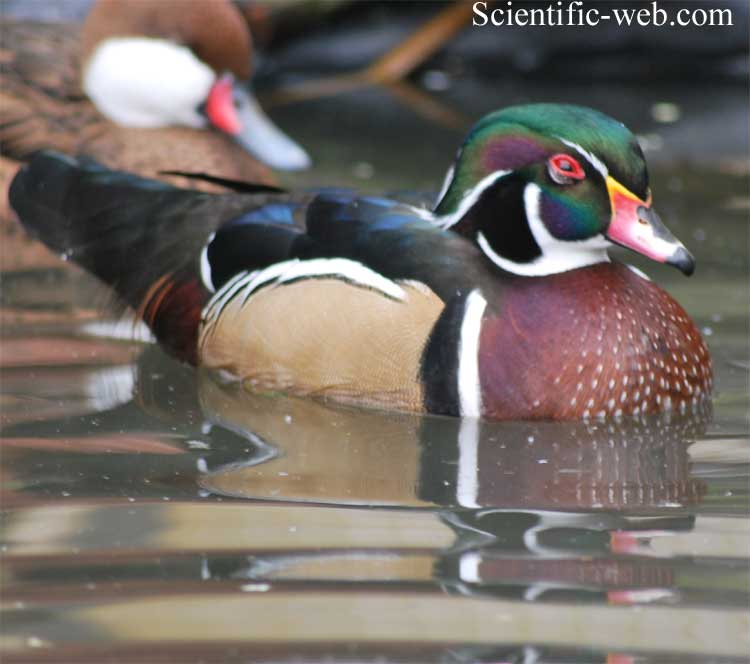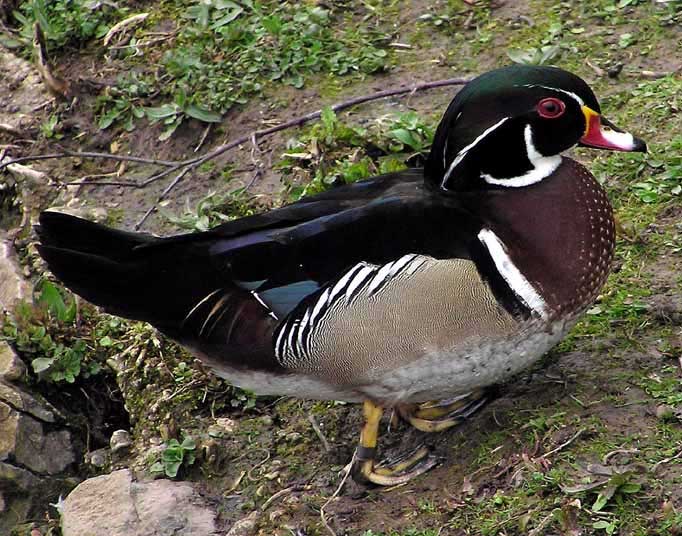
Aix sponsa , Photo: Michael Lahanas
Superregnum: Eukaryota
Cladus: Unikonta
Cladus: Opisthokonta
Cladus: Holozoa
Regnum: Animalia
Subregnum: Eumetazoa
Cladus: Bilateria
Cladus: Nephrozoa
Superphylum: Deuterostomia
Phylum: Chordata
Subphylum: Vertebrata
Infraphylum: Gnathostomata
Megaclassis: Osteichthyes
Cladus: Sarcopterygii
Cladus: Rhipidistia
Cladus: Tetrapodomorpha
Cladus: Eotetrapodiformes
Cladus: Elpistostegalia
Superclassis: Tetrapoda
Cladus: Reptiliomorpha
Cladus: Amniota
Classis: Reptilia
Cladus: Eureptilia
Cladus: Romeriida
Subclassis: Diapsida
Cladus: Sauria
Infraclassis: Archosauromorpha
Cladus: Crurotarsi
Divisio: Archosauria
Cladus: Avemetatarsalia
Cladus: Ornithodira
Subtaxon: Dinosauromorpha
Cladus: Dinosauriformes
Cladus: Dracohors
Cladus: Dinosauria
Ordo: Saurischia
Cladus: Eusaurischia
Cladus: Theropoda
Cladus: Neotheropoda
Cladus: Averostra
Cladus: Tetanurae
Cladus: Avetheropoda
Cladus: Coelurosauria
Cladus: Tyrannoraptora
Cladus: Maniraptoromorpha
Cladus: Maniraptoriformes
Cladus: Maniraptora
Cladus: Pennaraptora
Cladus: Paraves
Cladus: Eumaniraptora
Cladus: Avialae
Infraclassis: Aves
Cladus: Euavialae
Cladus: Avebrevicauda
Cladus: Pygostylia
Cladus: Ornithothoraces
Cladus: Euornithes
Cladus: Ornithuromorpha
Cladus: Ornithurae
Cladus: Carinatae
Parvclassis: Neornithes
Cohors: Neognathae
Cladus: Pangalloanserae
Cladus: Galloanseres
Ordo: Anseriformes
Familia: Anatidae
Subfamilia: Anatinae
Genus: Aix
Species: Aix sponsa
Name
Aix sponsa (Linnaeus, 1758)
Synonyms
Anas sponsa (protonym)

Aix sponsa, Photo : Adrian Pingstone
References
Linnaeus, C. 1758. Systema Naturae per regna tria naturæ, secundum classes, ordines, genera, species, cum characteribus, differentiis, synonymis, locis, Tomus I. Editio decima, reformata. Holmiæ: impensis direct. Laurentii Salvii. i–ii, 1–824 pp DOI: 10.5962/bhl.title.542: 128. Reference page.
Vernacular names
العربية: بطة الغياض
български: Каролинка
brezhoneg: Houad Carolina
català: Ànec de Carolina
čeština: Kachnička karolínská
Cymraeg: Hwyaden coed
dansk: Brudeand
Deutsch: Brautente
English: Wood Duck
Esperanto: Karolina anaso
español: Pato Joyuyo
فارسی: اردک جنگلی
suomi: Morsiosorsa
français: Canard branchu
Gaeilge: Lacha choille
עברית: ברווז עצים
hrvatski: Karolinka
magyar: Karolinai réce
íslenska: Brúðönd
italiano: Anatra sposa
日本語: アメリカオシ
ქართული: მეხეური იხვი
한국어: 아메리카원앙
lietuvių: Miškinė antis
latviešu: Koku pīle
македонски: Каролинка
Bahasa Melayu: Itik Kayu
Nederlands: Carolina-eend
norsk: Brudeand
Diné bizaad: Naalʼeełí naashchʼąąʼígíí
polski: Karolinka
português: Pato-carolino
română: Rață cu ochi de șoim
русский: Каролинская утка
srpskohrvatski / српскохрватски: Karolinka
slovenčina: Kačička obojková
svenska: Brudand
தமிழ்: மர வாத்து
українська: Каролінка
Tiếng Việt: Vịt gỗ
中文: 林鸳鸯
The wood duck or Carolina duck (Aix sponsa) is a species of perching duck found in North America. The drake wood duck is one of the most colorful North American waterfowl.[2][3]
Wood duck in flight
Wood duck
Lifting off to fly
Description
Close up of male head
Female at Yellow Lake
The wood duck is a medium-sized perching duck. A typical adult is from 47 to 54 cm (19 to 21 in) ( or 1.5 feet max.) In length with a wingspan of between 66 to 73 cm (26 to 29 in). The wood duck's weight ranges from 454-862 g (16.0-30.4 oz).[4] This is about three-quarters of the length of an adult mallard. It shares its genus with the Asian Mandarin duck (Aix galericulata).[2]
The adult male has stunning multicolored iridescent plumage and red eyes, with a distinctive white flare down the neck. The female, less colorful, has a white eye-ring and a whitish throat. Both adults have crested heads.
The male's call is a rising whistle, jeeeeee; the females utter a drawn-out, rising squeal, do weep do weep, when flushed, and a sharp cr-r-ek, cr-e-ek for an alarm call.[5]
Behavior
Their breeding habitat is wooded swamps, shallow lakes, marshes, ponds and creeks in the eastern United States, the west coast of the United States, some adjacent parts of southern Canada, and the west coast of Mexico. They usually nest in cavities in trees close to water, although they will take advantage of nesting boxes in wetland locations. Other species may compete with them for nesting cavities, such as birds of prey, as well as mammals such as grey squirrels, and these animals may also occupy nest boxes meant for wood ducks. Wood ducks may end up nesting up to a mile away from their water source as a result. [6] Females line their nests with feathers and other soft materials, and the elevation provides some protection from predators.[7] Unlike most other ducks, the wood duck has sharp claws for perching in trees and can, in southern regions, produce two broods in a single season—the only North American duck that can do so.[5]
Females typically lay between 7 and 15 white-tan eggs that incubate for an average of 30 days.[5] However, if nesting boxes are placed too close together, females may lay eggs in the nests of their neighbours, which may lead to nests which may contain as many as 30 eggs and unsuccessful incubation, a behaviour known as "nest dumping".[8]
After hatching, the precocial ducklings climb to the opening of the nest cavity, jump down from the nest tree and make their way to water. The mother calls them to her, but does not help them in any way.[7] They prefer nesting over water so the young have a soft landing, but will nest up to 140 m (460 ft) away from the shoreline. The day after they hatch, the young climb to the nest entrance and jump to the ground. The ducklings can swim and find their own food by this time."
These birds feed by dabbling or walking on land. Dabbling means to search for food from the surface of the water, as opposed to diving underneath the surface to scavenge for food.[clarification needed] They mainly eat berries, acorns, and seeds, but also insects, making them omnivores.[7]
Distribution
In Central Park, New York, USA
The birds are year-round residents in parts of its southern range, but the northern populations migrate south for the winter.[9][10] They overwinter in the southern United States near the Atlantic Coast. 75% of the wood ducks in the Pacific Flyway are non-migratory.[10] Due to their attractive plumage, they are also popular in waterfowl collections and as such are frequently recorded in Great Britain as escapees—populations have become temporarily established in Surrey in the past, but are not considered to be self-sustaining in the fashion of the closely related mandarin duck. Along with the mandarin duck, the wood duck is considered an invasive species in England and Wales, and it is illegal to release them into the wild.[11] Given its native distribution, the species is also a potential natural vagrant to Western Europe and there have been records in areas such as Cornwall, Scotland and the Isles of Scilly, which some observers consider may relate to wild birds; however, given the wood duck's popularity in captivity, it would be extremely difficult to prove their provenance. There is a small feral population in Dublin.
Conservation
The population of the wood duck was in serious decline in the late 19th century as a result of severe habitat loss and market hunting both for meat and plumage for the ladies' hat market in Europe. By the beginning of the 20th century, wood ducks had virtually disappeared from much of their former range. In response to the Migratory Bird Treaty established in 1916 and enactment of the U.S. Migratory Bird Treaty Act of 1918, wood duck populations began to recover slowly. By ending unregulated hunting and taking measures to protect remaining habitat, wood duck populations began to rebound in the 1920s. The development of the artificial nesting box in the 1930s gave an additional boost to wood duck production.[12] More information on the efficacy of nest boxes can be found in the Conservation Evidence webpage.[13]
Landowners as well as park and refuge managers can encourage wood ducks by building wood duck nest boxes near lakes, ponds, and streams. Fulda, Minnesota has adopted the wood duck as an unofficial mascot, and a large number of nest boxes can be found in the area.
Expanding North American beaver populations throughout the wood duck's range have also helped the population rebound as beavers create an ideal forested wetland habitat for wood ducks.[10]
The population of the wood duck has increased a great deal in the last several years. The increase has been due to the work of many people constructing wood duck boxes and conserving vital habitat for the wood ducks to breed. During the open waterfowl season, U.S. hunters have only been allowed to take two wood ducks per day in the Atlantic and Mississippi Flyways. However, for the 2008–2009 season, the limit was raised to three. The wood duck limit remains at two in the Central Flyway and at seven in the Pacific Flyway. It is the second most commonly hunted duck in North America, after the mallard.
In popular culture
In 2013, the Royal Canadian Mint created two coins to commemorate the wood duck. The two coins are each part of a three coin set to help promote Ducks Unlimited Canada as well as celebrate its 75th anniversary.[14] It is featured in James Thurber's short story "The Wood Duck".
References
BirdLife International (2016). "Aix sponsa". IUCN Red List of Threatened Species. 2016: e.T22680104A92843477. doi:10.2305/IUCN.UK.2016-3.RLTS.T22680104A92843477.en. Retrieved 19 November 2021.
"Wood Duck". All About Birds. Cornell Lab of Ornithology. Retrieved 9 July 2010.
Dawson, William (2007). Neher, Anna (ed.). Dawson's Avian Kingdom Selected Writings. California Legacy. pp. 37–38. ISBN 978-1-59714-062-1.
"Wood Duck Identification, All About Birds, Cornell Lab of Ornithology". www.allaboutbirds.org. Retrieved 26 September 2020.
"Wood Duck". Ducks Unlimited Canada. Archived from the original on 11 March 2015. Retrieved 1 December 2014.
Hoch, Greg (2020). "Cavities and Boxes". With Wings Extended. Iowa City: University of Iowa Press. p. 52. ISBN 9781609386955.
"Wood Duck Fact Sheet, Lincoln Park Zoo". lpzoo.org. Retrieved 24 August 2013.
"Wood Duck (Aix sponsa) Dump-Nests". Northern Prairie Wildlife Research Center. Retrieved 13 January 2012.
"Wood Duck". Hinterland's Who's Who. Archived from the original on 23 December 2014. Retrieved 1 December 2014.
"Wood Duck". BirdWeb: The Birds of Washington State. Seattle Audubon Society. Retrieved 9 July 2010.
Schedule 9 to the Wildlife and Countryside Act, 1981
Wood Duck (Aix sponsa) (PDF) (Report). USDA Natural Resources Conservation Service. Retrieved 9 July 2010.[permanent dead link]
"Wood Duck (Aix sponsa)". Conservation Evidence. Retrieved 14 February 2020.
"Royal Canadian Mint Coins Celebrate the 75th Anniversary of Ducks Unlimited Canada While Honouring Other Icons of Canadian Nature, Culture And History". Mint.ca. 6 March 2013. Retrieved 24 August 2013.
Retrieved from "http://en.wikipedia.org/"
All text is available under the terms of the GNU Free Documentation License

